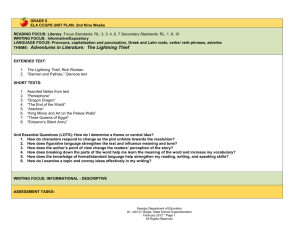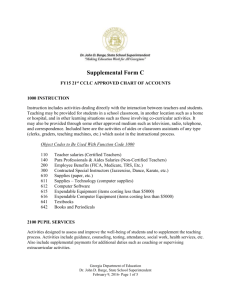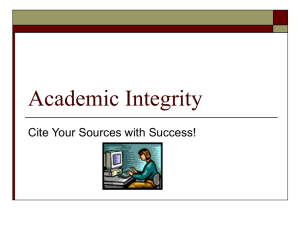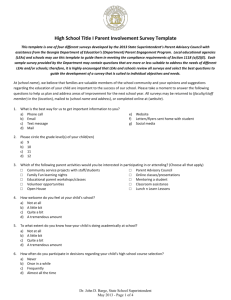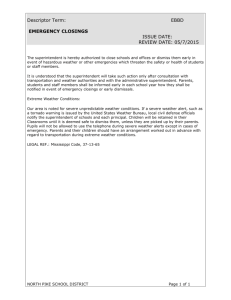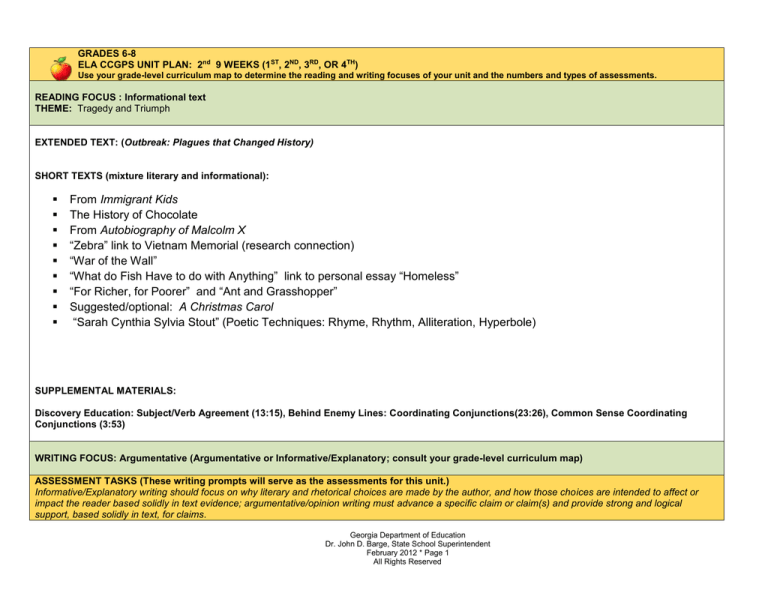
GRADES 6-8
ELA CCGPS UNIT PLAN: 2nd 9 WEEKS (1ST, 2ND, 3RD, OR 4TH)
Use your grade-level curriculum map to determine the reading and writing focuses of your unit and the numbers and types of assessments.
READING FOCUS : Informational text
THEME: Tragedy and Triumph
EXTENDED TEXT: (Outbreak: Plagues that Changed History)
SHORT TEXTS (mixture literary and informational):
From Immigrant Kids
The History of Chocolate
From Autobiography of Malcolm X
“Zebra” link to Vietnam Memorial (research connection)
“War of the Wall”
“What do Fish Have to do with Anything” link to personal essay “Homeless”
“For Richer, for Poorer” and “Ant and Grasshopper”
Suggested/optional: A Christmas Carol
“Sarah Cynthia Sylvia Stout” (Poetic Techniques: Rhyme, Rhythm, Alliteration, Hyperbole)
SUPPLEMENTAL MATERIALS:
Discovery Education: Subject/Verb Agreement (13:15), Behind Enemy Lines: Coordinating Conjunctions(23:26), Common Sense Coordinating
Conjunctions (3:53)
WRITING FOCUS: Argumentative (Argumentative or Informative/Explanatory; consult your grade-level curriculum map)
ASSESSMENT TASKS (These writing prompts will serve as the assessments for this unit.)
Informative/Explanatory writing should focus on why literary and rhetorical choices are made by the author, and how those choices are intended to affect or
impact the reader based solidly in text evidence; argumentative/opinion writing must advance a specific claim or claim(s) and provide strong and logical
support, based solidly in text, for claims.
Georgia Department of Education
Dr. John D. Barge, State School Superintendent
February 2012 * Page 1
All Rights Reserved
Based on what you have learned about issues of homelessness and various strategies used to address those issues, select
and defend a strategy that you think would be effective in solving the homelessness problem, or propose an alternative
strategy to address issues of homelessness. Be sure to use evidence to support your claim.
2. An epidemic is a widespread problem that affects many people. Research some modern epidemics. See attached
resources to expose (no pun intended) your students to some modern epidemics, such as Internet Addiction, Childhood
Obesity, and Texting while driving. Students should pick one and argue if it is indeed an epidemic or not and support their
positions with evidence and cite several sources.
3. Should it be mandatory for citizens to have a flu shot? Giving at least three reasons, pick a side, and justify your position
with evidence.
4. After reading the fable “Ant and the Grasshopper” and the modern fable “The Richer, the Poorer”, discuss the keys to a
successful future and defend your position using relevant evidence.
1.
(UP TO TWO ADDITIONAL ANALYSIS PROMPTS PER UNIT AT INSTRUCTOR DISCRETION)
5.
6.
NOTE: AT LEAST 3 OF THE MINIMUM OF 4 ANALYSIS ESSAYS MUST BE WITH THE GENRE FOCUS IDENTIFIED FOR THE UNIT
NARRATIVE/RESEARCH/ROUTINE WRITING
NARRATIVE
1. Write a personal narrative that tells the story of a triumph over a personal obstacle.
2. Write a personal narrative that tells the story of a personal, family, or tragedy.
3. Interview a family member who remembers a tragedy from American history (i.e. 9/11, MLK Jr. assassination, JFK assassination, 1986 Challenger
explosion) or a family tragedy.
4. Write a narrative using poetry or prose from an imaginary character’s point of view that tells his or her story of triumph over tragedy.
Georgia Department of Education
Dr. John D. Barge, State School Superintendent
February 2012 * Page 2
All Rights Reserved
RESEARCH CONNECTION(S)
1)Vietnam Memorial
2)homelessness 3)preventing spread of disease
4)plagues throughout history
ROUTINE WRITING Notes, summaries, process journals, and short responses across all genres
Reflection to text
Create a journal/diary entry from the point of view of someone who survived one of the plagues
Found poetry (see page 46-47 of The Write to Read)
Summaries of various plagues from the past or the present
PLAN FOR INSTRUCTIONAL INTEGRATION OF LANGUAGE STANDARDS
ELACCL1
Function of phrases and clauses in general and their function in
specific sentences
Use simple, compound, complex, and compound-complex
sentences to signal differing relationships among ideas
Recognize and correct misplaced and dangling modifiers
Address serial commas in sets of coordinate adjectives
ELACCL2
Capitalization, punctuation, and spelling when writing
Use a comma to separate coordinate adjectives
ELACCL3
Choose language that expresses ideas precisely and concisely,
recognizing and eliminating wordiness and redundancy
Examine and compare the prose styles of each author (for
distribution of simple, compound, and complex sentences)
Examine syntax and use of introductory subordinate clauses
Combine sentences for fluency in writing process
Place attention on dangling modifiers in rubric
Place attention on varied sentence structure on rubric
Diagram sentences from texts in exploration of style
Provide direct instruction in definition of phrase/clause and
misplaced modifiers
Place attention on conventions in rubric
Provide direct instruction on comma usage with coordinate
adjectives
Identify text examples of coordinate adjective lists
Compare and contrast author’s prose styles with attention to
diction
Give attention to concise language in class discussion
Georgia Department of Education
Dr. John D. Barge, State School Superintendent
February 2012 * Page 3
All Rights Reserved
ELACCL4
Determine or clarify the meaning of unknown and multiplemeaning words and phrases using multiple strategies including
context and reference materials
Greek or Latin affixes and roots
Employ thesaurus for precision
Eliminate extraneous/flowery language in writing process
Provide direct instruction in literary terms to scaffold analysis,
citing examples from texts (diction, syntax, tone, imagery,
figurative language, audience, purpose, theme, structure)
Use online and paper reference materials in class
Give attention to Greek and Latin vocabulary in Outbreak:
Plagues That Changed History as teachable moment for roots
Conduct vocabulary study in each text
Study figurative language and connotative language in texts
Give attention to figurative language in writing/rubric
Identify allusions in texts
ELACCL6
Acquire and use accurately academic and domain-specific
vocabulary
ELACCL5
Figurative language,
Biblical and mythological allusions
Synonyms
Connotations and denotations
PLAN FOR INSTRUCTIONAL INTEGRATION OF SPEAKING AND LISTENING STANDARDS
ELASL1
Express ideas clearly in collaborative discussions
Acquire and show evidence of knowledge of topic
Work well in group, set goals
Modify views when warranted
Engage in routine daily discussion of ideas
Express ideas in Paper 3 (Archetypes in Arthurian Legend)
may be written in pairs or teams as an academic presentation
that includes a visual component such as poster, Prezi, or
PowerPoint
Georgia Department of Education
Dr. John D. Barge, State School Superintendent
February 2012 * Page 4
All Rights Reserved
Engage in debate, formal and informal as issues arise
Engage in Peer Review of paper 3 presentations
Conduct evaluation of web resources in research process
Evaluate arguments presented in pivotal monologues from film
clips accompanying texts (for example, Gandalf’s argument
persuading Bilbo to go on the adventure, or Merlin’s speech
arguing that Arthur must get hold of himself and fight for
Camelot after Arthur is wounded and weakened)
ELASL4
Present claims and findings
Engage in Paper 3 Collaboration
ELASL5
Include multimedia components
Engage in Paper 3 Collaboration
ELASL6
Adapt speech to a variety of contexts and tasks
Note the differences in vocabulary and level of discourse
between informal discussion and formal presentation; note
differences in speech patterns of characters of different types
(royalty versus commoner, wizard versus monster, astronaut
versus farmer)
ELASL2
Analyze material presented in diverse media and formats
ELASL3
Delineate and evaluate a speaker’s argument
PLANS FOR ASSESSMENT 1: integrating reading selections from the unit into a writing task
Based on what you have learned about issues of homelessness and various strategies used to address those issues,
select a strategy that you think is effective and defend it or propose an alternative strategy to address homelessness. Be sure to use
evidence to support your claim.
PROMPT:
Georgia Department of Education
Dr. John D. Barge, State School Superintendent
February 2012 * Page 5
All Rights Reserved
SKILL BUILDING TASKS
Note: tasks may take more than a single day. Include a task to teach EVERY skill students will need to succeed on the assessment prompt above. Language,
Foundations, and Speaking/Listening standards must be incorporated so that all standards are adequately addressed throughout the year.
ESSENTIAL QUESTION: How can I use the research process to answer my questions and generate more questions?
TASK: Generate research questions.
Standards:
ELACC7W7: Conduct short research projects to answer a question, drawing on several sources and generating additional related, focused questions for
further research and investigation
Instruction:
KWL-Homelessness
Read selection-“Homelessness” p.101
Generate research questions (We want the kids to go in the direction of issues relating to homelessness and ways that city governments address those
issues.)
ESSENTIAL QUESTION: How can I use a variety of resources to find relevant information?
TASK: Use sources to find information relevant to research.
Standards:
ELACC7W8: Gather relevant information from multiple print and digital sources, using search terms effectively; assess the credibility and accuracy of each
source; and quote or paraphrase the data and conclusions of others while avoiding plagiarism and following a standard format for citation.
Instruction:
Direct students to generate ideas about how government should address the problem.
Share and discuss the NPR story.
Generate additional research questions.
Discuss keywords used for Internet searches.
ESSENTIAL QUESTION: How can avoid plagiarism?
TASK: Citing or paraphrasing information from sources.
Standards:
ELACC7W8: Gather relevant information from multiple print and digital sources, using search terms effectively; assess the credibility and accuracy of each
source; and quote or paraphrase the data and conclusions of others while avoiding plagiarism and following a standard format for citation.
Georgia Department of Education
Dr. John D. Barge, State School Superintendent
February 2012 * Page 6
All Rights Reserved
Instruction:
Discuss the meaning of plagiarism
Discuss the consequences of plagiarism
Model paraphrasing
BrainPOP-plagiarism, citing sources
ESSENTIAL QUESTION: How can I use reasons and evidence to support a claim?
TASK: Plan your argument to support your claim.
Standards:
ELACC7W1: Write arguments to support claims with clear reasons and relevant evidence
Instruction:
Graphic Organizer-Planning Argumentative Essay
Guided instruction and practice on making claims
(Examples) School Uniforms, Appropriate Age for Cell Phones, Driving Age
Choose a claim and model how to support it.
ESSENTIAL QUESTION: How do I follow the step of the writing process to publish a final draft?
TASK: Publish a final draft.
Standards:
ELACC7W4: Produce clear and coherent writing in which the development, organization, and style are appropriate to task, purpose, and audience. (Gradespecific expectations for writing types are defined in standards 1-3 above.)
ELACC7W5: With some guidance and support from peers and adults, develop and strengthen writing as needed by planning, revising, editing, rewriting, or
trying a new approach, focusing on how well purpose and audience have been addressed. (Editing for conventions should demonstrate command of Language
standards)
ELACC7W6: Use technology, including the Internet, to produce and publish writing and link to and cite sources as well as to interact and collaborate with
others, including linking to and citing sources
Instruction:
Draft
Share specific revising and editing strategies (See Language Network)
BrainPOP (writing process)
Georgia Department of Education
Dr. John D. Barge, State School Superintendent
February 2012 * Page 7
All Rights Reserved
ESSENTIAL QUESTION: How does Avi develop contrasting points of view related to the homeless man in “What do Fish have to do with Anything”?
TASK: Analyze the two points of view (mother and boy).
Standards:
ELACC7RL6: Analyze how an author develops and contrasts the points of view of different characters or narrators in a text.
Instruction:
Pre-reading activity: discuss some common opinions/views of homeless people and how to approach them if at all
ESSENTIAL QUESTION: What is theme and how does Avi develop theme in “What do Fish have to do with Anything?”
TASK: Determine the theme of this selection.
Standards:
ELACC7RL2: Determine a theme or central idea of a text and analyze its development over the course of the text; provide an objective summary of the text.
Instruction:
Think back to some fables, such as “Tortoise and the Hare”. All fables teach a lesson which is called a moral. What is the moral of “Tortoise and the
Hare”
Share some of Aesop’s fables and discuss the moral of each one.
Have students discuss some possible themes of “What do Fish have to do with Anything?”
PLANS FOR ASSESSMENT 2: integrating reading selections from the unit into a writing task
An epidemic is a widespread problem that affects many people. Research some modern epidemics. See attached
resources to expose (no pun intended) your students to some modern epidemics such as internet addiction, childhood
obesity, and texting while driving. Students should pick one and argue if it is indeed an epidemic or not and support their
positions with evidence and cite several sources. (Common Assessment)
PROMPT:
Georgia Department of Education
Dr. John D. Barge, State School Superintendent
February 2012 * Page 8
All Rights Reserved
SKILL BUILDING TASKS
Note: tasks may take more than a single day. Include a task to teach EVERY skill students will need to succeed on the assessment prompt above. Language,
Foundations, and Speaking/Listening standards must be incorporated so that all standards are adequately addressed throughout the year.
ESSENTIAL QUESTION: How did Bryn Barnard organize his text to give structure to the book Outbreak: Plagues that Changed History? How does
this historical account compare and contrast with a fictional portrayal of the same time period?
TASK: Read and take notes from the book (chunk in to sections). Compare and Contrast the section on yellow fever with an excerpt from the
novel Fever 1793.
Standards:
ELACC7RI5: Analyze the structure an author uses to organize a text, including how the major sections contribute to the whole and to the development of the
ideas
ELACC7RL9: Compare and contrast a fictional portrayal of a time, place, or character and a historical account of the same period as a means or
understanding how authors of fiction use or alter history
Instruction:
Pre-teach vocabulary (per section)
Provide note-taking guide
Use thinking maps (per section)
Find an excerpt to share or encourage some kids to read the novel independently so that they could compare and contrast things from the novel and
what they learned about yellow fever from the book Outbreak. All the media centers should have a copy of Laurie Halse Andersen’s novel Fever 1793.
See the resources and there is a link to American Plague, which is another historical account of yellow fever.
ESSENTIAL QUESTION: How can I use context clues to determine a word’s meaning?
TASK: Predict a word’s meaning based on its context and verify the meaning using a dictionary or the glossary in the back of Outbreak.
Standards:
ELACC7L4d: Verify the preliminary determination of the meaning of a word or phrase (e.g., by checking the inferred meaning in context or in a dictionary
ELACC7L4c: Consult general and specialized reference materials (e.g., dictionaries, glossaries, thesauruses), both print and digital, to find the pronounciation
or a word or determine or clarify its precise meaning or its part of speech
Instruction:
Explain different types of context clues (i.e. restatement, contrast, and example) See Language Network page 570-572.
Highlight some difficult terms from each section of Outbreak
Georgia Department of Education
Dr. John D. Barge, State School Superintendent
February 2012 * Page 9
All Rights Reserved
ESSENTIAL QUESTION How can I use the research process to answer my questions and generate more questions?
TASK: Generating research questions
Standards:
ELACC7W7: Conduct short research projects to answer a question, drawing on several sources and generating additional related, focused questions for
further research and investigation
Instruction:
See attached links/resources about modern epidemics: texting and driving, childhood obesity, internet addiction, and eating disorders. Share each one
and have students take notes on what they learned. Students should choose one epidemic and generate more research questions on that particular
modern epidemic.
Extend the research by answering their own research questions which will prepare them for the assessment task.
ESSENTIAL QUESTION How can I use reason and evidence to support a claim?
TASK: Plan your argument to support your claims
Standards:
ELACC7W1: Write arguments to support claims with clear reasons and relevant evidence.
Instruction:
Graphic Organizer-Planning Argumentative Essay
Guided instruction and practice on making claims
(Examples) School Uniforms, Appropriate Age for Cell Phones, Driving Age
Choose a claim and model how to support it.
ESSENTIAL QUESTION: How can avoid plagiarism?
TASK: Citing or paraphrasing information from sources
Standards:
ELACC7W8: Gather relevant information from multiple print and digital sources, using search terms effectively; assess the credibility and accuracy of each
source; and quote or paraphrase the data and conclusions of others while avoiding plagiarism and following a standard format for citation.
Instruction:
Review consequences of plagiarism.
Teach kids how to use online citation (see attached resources)
Also, use Language Network page 642+ to model how to cite a source in a bibliography
Georgia Department of Education
Dr. John D. Barge, State School Superintendent
February 2012 * Page 10
All Rights Reserved
ESSENTIAL QUESTION: How do I follow the step of the writing process to publish a final draft?
TASK: Publish a final draft.
Standards:
ELACC7W4: Produce clear and coherent writing in which the development, organization, and style are appropriate to task, purpose, and audience. (Gradespecific expectations for writing types are defined in standards 1-3 above.)
ELACC7W5: With some guidance and support from peers and adults, develop and strengthen writing as needed by planning, revising, editing,
rewriting, or
trying a new approach, focusing on how well purpose and audience have been addressed. (Editing for conventions should demonstrate command of Language
standards)
ELACC7W6: Use technology, including the Internet, to produce and publish writing and link to and cite sources as well as to interact and collaborate with
others, including linking to and citing sources
ELAGPS7C1.f (transition standard): Demonstrates appropriate comma and semicolon usage (compound, complex, and compound-complex sentences, and
split dialogue)
ELAGPS7C1.c (transition standard): Uses standard subject-verb and pronoun-antecedent agreement
Instruction:
Draft
Share specific revising and editing strategies (See Language Network)
Students will analyze their own drafts to ensure that the subject-verb agreement and the pronoun-antecedent agreement are correct.
Students should try to use at least one semicolon per paragraph.
BrainPOP (writing process)
ESSENTIAL QUESTION: How can I revise my draft to include a variety of sentence structures?
TASK: Combine simple sentences to form compound and complex sentences
Standards:
Georgia Department of Education
Dr. John D. Barge, State School Superintendent
February 2012 * Page 11
All Rights Reserved
ELACC7W5: With some guidance and support from peers and adults, develop and strengthen writing as needed by planning, revising, editing, rewriting, or
trying a new approach, focusing on how well purpose and audience have been addressed. (Editing for conventions should demonstrate command of Language
standards)
ELACC7W6: Use technology, including the Internet, to produce and publish writing and link to and cite sources as well as to interact and collaborate with
others, including linking to and citing sources
ELAGPS7C1.f (transition standard): Demonstrates appropriate comma and semicolon usage (compound, complex, and compound-complex sentences, and
split dialogue)
Instruction:
Students will analyze their own drafts to determine the complexity and variety of their sentences.
Students will combine simple sentences into compound or complex sentences.
Students should try to use at least one semicolon per paragraph.
Refer to Language Network for more instruction and practice on sentence structure and agreements.
ESSENTIAL QUESTION: How can I edit my draft to make sure I have not misused some commonly mistaken homonyms?
TASK: Use homonyms correctly.
Standards:
ELAGPS7C1.g (transition standard): Distinguishes differences in meaning and spelling of commonly confused homonyms.
Instruction:
Use the Three Little Pigs (see unit 2 folder word document) to make corrections to misused homonyms
BrainPOP (Their, There, and They’re)
Circle all the homonyms that you used in your draft. Have a peer editor check the accuracy of each one.
PLANS FOR ASSESSMENT 3: integrating reading selections from the unit into a writing task
PROMPT: Should it be mandatory for citizens to have a flu shot? Giving at least
three reasons, pick a side and justify your position
with evidence.
SKILL BUILDING TASKS
Note: tasks may take more than a single day. Include a task to teach EVERY skill students will need to succeed on the assessment prompt above. Language,
Foundations, and Speaking/Listening standards must be incorporated so that all standards are adequately addressed throughout the year.
ESSENTIAL QUESTION: How can I support my claim with logical reasoning and relevant evidence to justify my position?
Georgia Department of Education
Dr. John D. Barge, State School Superintendent
February 2012 * Page 12
All Rights Reserved
TASK: Support claims using logical reasoning and evidence
Standards:
ELACC7W1.a: Introduce claim(s), acknowledge alternate or opposing claims, and organize the reasons and evidence logically.
ELACC7W1.b: Support claim(s) with logical reasoning and relevant evidence, using accurate, credible sources and demonstrating an understanding of the
topic or text.
Instruction:
Using Think Pair and Share, students will discuss their position.
While using the Argumentative Graphic Organizer, students will state their claims along with providing reasons and supportive evidence.
Show Kleenex Commercial (Shield Sneeze Swish) via YouTube and retrieve lyrics from resource page.
Create a poster, banner, or Public Service Announcement, which supports your claim. Turn your argument into a work of art. Students may create their
own slogans.
Stage an art gallery in your classroom of student’s works of art. Allow students to walk around. They should respond in writing to at least one piece that
caught their attention.
ESSENTIAL QUESTION: How can I use the book, Outbreak The Plagues That Have Changed History, to cite evidence from the text?
TASK: Cite several pieces of textual evidence to support an analysis of the text
Standards:
ELACC7RI1: Cite several pieces of textual evidence to support analysis of what the text says explicitly as well as inferences drawn from the text.
Instruction:
Using the book, Outbreak Plagues That Changed History, students will find evidence to support their reasons.
ESSENTIAL QUESTION: How can I avoid plagiarism?
Georgia Department of Education
Dr. John D. Barge, State School Superintendent
February 2012 * Page 13
All Rights Reserved
TASK: Citing or paraphrasing information from sources
Standards:
ELACC7W8: Gather relevant information from multiple print and digital sources, using search terms effectively; assess the credibility and accuracy of each
source; and quote or paraphrase the data and conclusions of others while avoiding plagiarism and following a standard format for citation.
Instruction:
Review consequences of plagiarism.
Teach kids how to use online citation (see attached resources)
Also, use Language Network page 642+ to model how to cite a source in a bibliography
ESSENTIAL QUESTION: How do I follow the step of the writing process to publish a final draft?
TASK: Publish a final draft.
Standards:
ELACC7W4: Produce clear and coherent writing in which the development, organization, and style are appropriate to task, purpose, and audience. (Gradespecific expectations for writing types are defined in standards 1-3 above.)
ELACC7W5: With some guidance and support from peers and adults, develop and strengthen writing as needed by planning, revising, editing,
rewriting, or
trying a new approach, focusing on how well purpose and audience have been addressed. (Editing for conventions should demonstrate command of Language
standards)
ELACC7W6: Use technology, including the Internet, to produce and publish writing and link to and cite sources as well as to interact and collaborate with
others, including linking to and citing sources
ELAGPSC1.f (transition standard): Demonstrates appropriate comma and semicolon usage (compound, complex, and compound-complex sentences, and
split dialogue)
Instruction:
Draft
Review specific revising and editing strategies (See Language Network)
PLANS FOR ASSESSMENT 4: integrating reading selections from the unit into a writing task
Georgia Department of Education
Dr. John D. Barge, State School Superintendent
February 2012 * Page 14
All Rights Reserved
After reading the fable “Ant and the Grasshopper” and the modern fable “The Richer, the Poorer”, discuss the keys
to a successful future and defend your position using relevant evidence.
PROMPT:
SKILL BUILDING TASKS
Note: tasks may take more than a single day. Include a task to teach EVERY skill students will need to succeed on the assessment prompt above. Language,
Foundations, and Speaking/Listening standards must be incorporated so that all standards are adequately addressed throughout the year.
ESSENTIAL QUESTION: What is theme? How does the author develop theme in these two selections?
TASK: Read selections and determine possible themes.
Standards:
ELACC7RL2: Determine a theme or central idea of a text and analyze its development over the course of the text; provide an objective summary of the text.
Instruction:
Briefly review theme.
Rephrase the theme at the bottom of the selection on page 313. Explain how the ant’s actions supported the theme.
After reading the selection “The Richer, the Poorer” have students brainstorm themes for this selection and support the theme of their choice with
details from the selection.
ESSENTIAL QUESTION: How does the setting affect the plot?
TASK: Describe how setting affects plot.
Standards:
ELACC7RL3: Analyze how particular elements of a story or drama interact (e.g., how settings shape the characters or plot).
Instruction:
Read about the author and discuss the times in which she grew up.
Read the selection and review setting which is time and place. Point out that the author doesn’t directly state the setting.
Analyze the word choice and details of the story that help you infer the setting.
Georgia Department of Education
Dr. John D. Barge, State School Superintendent
February 2012 * Page 15
All Rights Reserved
ESSENTIAL QUESTION: How do the graphics of the poem on page 314 affect its form?
TASK: Analyze effects of form between the same story told in prose and retold in verse.
Standards:
ELA7GPSR1.g.iii (transition standard): Graphics (e.g., capital letters, line length, word position)
Instruction:
Read the two selections. Compare and contrast the prose and the verse.
ESSENTIAL QUESTION: How do I cite evidence from the text to infer characteristics of Lottie and Bess?
TASK: Describe each sister and use evidence to support your description.
Standards:
ELACC7RL1: Cite several pieces of textual evidence to support analysis of what the text says explicitly as well as inferences drawn from the text.
Instruction:
As students read the selection, they could take notes on each sister using a t-chart.
See resources for a link to a “Traits Chart”. Students will judge the character of each sister and use evidence from the text to support their judgment of
each sister’s character.
Narrative
Write a personal narrative
that tells the story of a
triumph over a personal
obstacle.
Write a personal narrative
that tells the story of a
personal, family, or local
tragedy.
Write a narrative using poetry or
prose from an imaginary
character’s point of view that tells
his or her story of triumph over
tragedy.
Georgia Department of Education
Dr. John D. Barge, State School Superintendent
February 2012 * Page 16
All Rights Reserved
Selections to support it
Standards
EQ
Research connections
Key terms
“Zebra” “Autobio of Malcolm X”
“Immigrant Kids”
CC7RL1, CC7RL6
CC7W3, CC7W5
“War of the Wall”
“Sarah Cynthia Sylvia Stout”
CC7RL1, CC7RL6, CC7W3,
CC7W5
How do I support my
inferences with evidence from
the text? How does the author
develop contrasting points of
view with Zebra and John
Wilson? Who is the
protagonist? Who or what is
the antagonist? What is a
dynamic character? What is a
static character? Give an
example for each.
What are some important
factors in writing a narrative
that is well-structured and
engaging to the reader? (see
CC7W3 sub-standards a-e)
Vietnam Memorial
Protagonist, antagonist,
Plot, conflict, dynamic and
static characters
How do I support my
inferences with evidence from
the text? How does the author
develop contrasting points of
view with the kids from the
neighborhood and Painter
Lady? Who is the
protagonist? Who or what is
the antagonist? What are
some important factors in
writing a narrative that is wellstructured and engaging to the
reader? (see CC7W3 substandards a-e)
Transition standard ELA 7R1.g.i
(sound devices), CC7RL4,
CC7RL5, CC7W3, and CC7W5
How can I ensure that my
narrative includes the character’s
point of view by telling his or her
story of triumph over tragedy?
What is alliteration? What is
rhyme? What is rhyme scheme?
What is rhythm? What is a
hyperbole?
Vietnam veterans
Protagonist, antagonist,
Plot, conflict, dynamic and
static characters
Alliteration, rhyme, rhyme
scheme, rhythm, narrative poem,
hyperbole
Georgia Department of Education
Dr. John D. Barge, State School Superintendent
February 2012 * Page 17
All Rights Reserved

